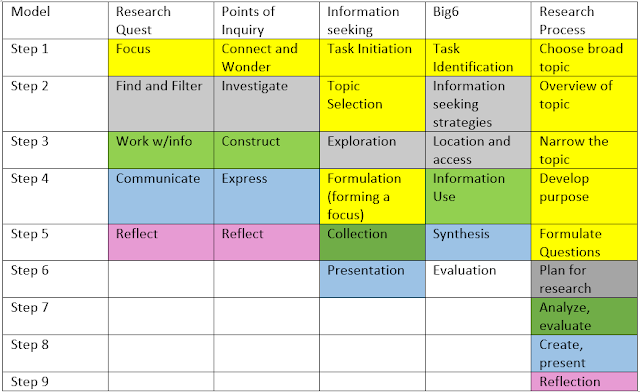LIBE 467 Information Services 1: Blog Post Theme 1
A teacher-librarian has an important role to fill in the school. They need to have excellent knowledge of the resources in the library, they need to be able to talk to students and staff, and finally they need to be able to choose the best resources to help students and staff meet curricular outcomes (Riedling, 2013, 4). In beginning this course, I recognize how important it is to start with a clear understanding of ‘reference sources and services.' The teacher-library is tasked with the job of “assisting students in finding the answers to questions and helping them become independent users of information and ideas” (Riedlling, 2013, 4). To do this we need an understanding of how best to help students use reference sources “materials, from book to computer to periodical to photograph that can be found anywhere in the library or online” (Riedling, 2013, 18). The Teacher-librarian also needs to understand and be able to employ a variety of inquiry models to guide students as they engage in research to answer questions and learn. It is a lot more complicated than it sounds, just take a look at this chart comparing 5 different inquiry models.
Chart: Comparison of Inquiry models (Riedling, 2013, p.10) (Beaudry, 2019, Course notes, lesson two) (BCTLA, https://bctladotca.files.wordpress.com/2018/02/the-points-of-inquiry.pdf (Links to an external site.))
The colours indicate areas of similarity. Each model requires that students learn and master tasks so that they can effectively engage in inquiry. Questioning and writing questions is an area where students have to learn and practice so that they can explore deeply.
Once they have a direction for inquiry students need guidance, and resources so that they can investigate and explore. The necessity of selecting the best possible reference resources has become a priority. I was alarmed when comparing the current library reference materials with the standards listed in Achieving Information Literacy. I was especially concerned with the fact that many of the reference sources are long past their best before dates and do not meet the benchmark of “copyright dates within the last 10 years” (Asselin, 2003, 33). Fewer than 50% of the reference resources have copyright dates within the last 10 years and many are much older. Evaluating these resources will provide an opportunity to acquire more appropriate and useful materials for students and staff. These are not the type of accurate resources needed by the student body. Two areas in the reference section that met the criteria: the new dictionaries and the new Indigenous atlas set.


What I need to work toward is the trifecta of the Library Learning Commons—becoming a more skilled teacher-librarian, acquiring the best reference resources, and assisting students to inquire and learn.
Asselin, M., Branch, J., & Oberg, D., (Eds) (2003). Achieving information literacy: Standards for school library programs in Canada. Ottawa, ON: Canadian School Library Association & The
Association for Teacher-Librarianship in Canada.
BCTLA. (2011). The points of inquiry: A framework for information literacy and the 21st century learner. https://bctladotca.files.wordpress.com/2018/02/the-points-of-inquiry.pdf (Links to an external site.)
Beaudry, R. (2019). Lesson 2: The Reference Process and Information Skills, Course notes. Retrieved from https://canvas.ubc.ca/courses/41996/pages/lesson-2-the-reference-process-and-information-skills?module_item_id=1308244
Riedling, A. (2013). Reference skills for the school library media specialist: Tools and tips, (Third Edition). Santa Barbara, CA: Linworth.

I agree with you when you state that we need to become more skilled teacher librarians. I need some insight and clarification how and in what skills when there seems to be so many that are needed to be skilled TL's! I am hoping this course can provide some answers!
ReplyDeleteI really like how you've compared the different research process with the use of a table. There are many similaties that are apparent when looking at it that way.
ReplyDeleteYour point about becoming skilled a skilled teacher librarian is a good one. As the job evolves to keep up with changes toward a Learning Commons model, the skills that are required change too.
Thanks for the helpful colour-coded chart that outlines the similarities and differences between the inquiry/research processes! This is so helpful for a visual learner like me.
ReplyDeleteOur reference sections are pretty similar - ours is also quite small and a bit older.
Thanks for sharing your goals with us, too!